|
10/20/13 – In Transit – Blips from an Auto Pilot / Brain Dead Experience
Brian, Amy, Zion and Molly drop us off at the airport at 6:30 pm. We say our “Good-bye’s” and our “Miss you’s.” They go off to have dinner at one of the restaurants on India Street to honor us – Indian food, get it? We face lines, airport security and all nature of pre-boarding / boarding rituals. Although I must say things go rather smoothly. The flight is almost full. We’re thrilled that no one is assigned to the seat separating us – nice to have extra room for a nice airplane snoozing position.
I read my free Kindle book about the impressions of 40 travelers who went to India. Each story had a similar theme – the juxtaposition of beauty and grossness – Spiritual and Spit, Curry and Urine, Culture and Crap. The 40 travelers were each on a spiritual quest, drawn to India by some magical force. For us, it was just another place to check off our bucket list, so I doubt that we’ll have similar experiences. Frankly, the short story authors seem a little short on sense and a lot short on cash. Enough judging. The book didn’t prepare me for what I was about to experience – although it would be nice to have a little magic drop into my oh-so-normal life.
On the plane I watch parts of several movies – all too loud, too boring, too silly. I am interrupted by a surprisingly lovely chicken curry dinner and some fairly nice French white wine. Along with an Ambien, I sprawl my butt other the middle seat and go into a deep sleep. Thank God for Ambien! The next thing I know it’s breakfast – yogurt, hard roll, juice and coffee – only one precious cup of coffee – no time for seconds by the time we land in London. Amazing world, we jump into a silver capsule in San Diego and 10 hours later, we jump across a mass continent and a rather large pond (that would be the Atlantic Ocean).
We go through the motions passing through security and finding our next silver body to jump on. I find just enough time to treat myself to a $25 chair massage. Hitting all those pressure / acupuncture spots revives the old bod enough to face another 8 hours in the air. We board a FULL airplane – no extra space here. A quiet, on-the-large-side, young Indian guy, who hails from Dallas, sits between us. He is on a business trip, and can’t help but spill over onto both of our precious airplane space. I learn to accept his pillowy arms – but it is rather difficult to accept the constant tic that has possessed his left leg. The motor driven leg never shuts off, even while he’s sleeping. I manage to get a few winks and hold my bladder until the trays are removed. I make a mad dash to the toilets -- haven’t had to pee that bad in ages. A very sweet Indian man sees my desperation and lets me break up in line. God bless him!
We emerge from the silver capsule in Dehli at 6:30 am local time. The airport designed to move many was almost empty and very surreal. We change some money. Bill buys water. I debate about a beer, but then remember it’s still morning. My body is crying “Happy Hour,” but I restrain myself and roam the long, empty corridors, getting some exercise and giving Bill a little break from me (and me from him)!
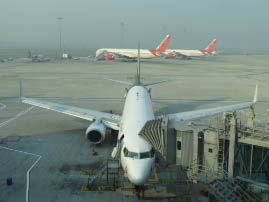
New Delhi Airport |
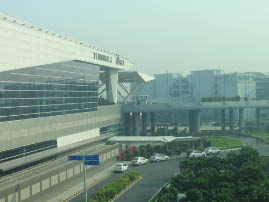 New Delhi Airport
|
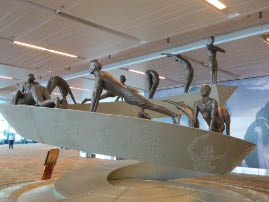
New Delhi Airport |
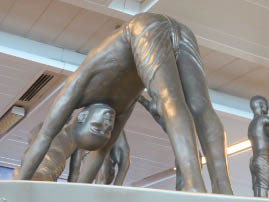
New Delhi Airport |
Finally it’s time to board our last flight – on to Calcutta (Kolkata). It’s only a 2-hour journey, but we are worn down. We are lucky again – no one in the center seat. However, a very bratty, whiney, screechy 3-year old occupies the seat just in front of us. My nerves are shot. She did simmer down during the flight so all my worry and angst was for naught.
I am thrilled to finally land in Calcutta. Only customs blocks us from our freedom. We make it along with both of our bags. We find our way to the pre-paid taxi line to pre-pay for our taxi (what a concept) and then find our way outside to the long line to get the taxi. Our turn comes quickly and before long, we head to our hotel in downtown Calcutta only 12–15 miles away.
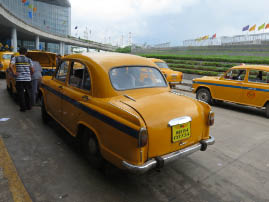
Catching a taxi at Calcutta Airport |
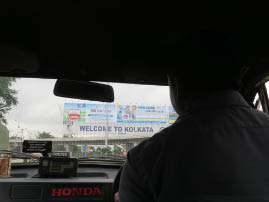
Driving to Our Hotel |
Our driver is friendly, but speaks very little English. Right outside the airport, he pulls over and jumps out of the cab to take a piss by the road. I would grow accustom to this Indian male behavior. I see the backs of many a brown body with a stream of urine hitting the ground in front of them. The cab driver also manages to spit out the window every block or two. I’m surprised it didn’t disgust me more. I marvel at how one mouth could produce so much saliva, but later grew to understand that it is in the genetic makeup of most Indian males. (Or maybe, one has to be in training. Later I realize that the substance is not saliva, but rather flem. How do the lungs manage that amount of flim production?)
It takes over an hour for the 10 or so mile cab ride to the hotel. It is true what they say about traffic in India – absolutely no hint of designated lanes. I feel close and almost bond with the occupants in the vehicles that inch along right next to us. In the US, I would think of them as the enemy -- road hogs, encroaching on my space; but here I feel they are my brethren.
My brain fills with first impressions of India. It is all that I expected – crowded, well worn, and unsanitary – topped off with an aura of grossness. What I didn’t expect was the scenes didn’t bother me. I am in the swirl of life – bodily functions and all. Great to be here!
We arrive at our hotel – The Park Kolkata. The driver delivers us through an underground passage. I expected a colonial, proper British structure, but what I get is James Bond, circa 1970. The lobby is encased in a dark hole with modern décor -- or rather, what someone thought was modern in the 1980’s. The shining marble floors play havoc with my depth perception. The place is clean and efficient and creepy all at the same time.
Our room is on the second floor - #238. Inside we find more black shiny stuff accented with red highlights. The floor plan is well organized, but I feel as if I’m entering a mausoleum. We drop our luggage and head for the coffee shop for lunch. Wouldn’t you know it – all we find is an all you can eat buffet. We negotiate a simple something – a roll thing stuffed with chicken, onion and bell pepper – very tasty, especially when washed down by the beer.
Happy us return to the room for a shower and rest. We conk out about 2 in the afternoon, not to awake again until almost 6. Feeling hypnotized, I just couldn’t get the old bod into gear. Bill takes charge and finds a restaurant recommended by Lonely Planet just a few blocks away.
We find the restaurant – it’s a great place – and the real deal. The food is excellent – especially the naan bread. We’re very, very happy. After my tummy is full, the extreme need for sleep takes over. Being a full-on insomniac, I revel in the most relaxed feeling. So this is what it feels like to be naturally sleepy. Bill coaxes me to stay awake as we stumble back to the hotel over the broken sidewalks and then onto the dangerous, illusive marble floors that take us to our mausoleum of a room. I go into the most deep sleep, only to be interrupted at 11:30 pm -- someone delivering bottles of water. We didn’t order them, but I take them anyway just to get back to my deep, wonderful sleep.
10/23/13--Calcutta (Kolkata)
We awake and get ready for the the restaurant to open. Breakfast is delightful – delicious omelets and fruit and cappuccino and cereal and yogurt. I tank up nicely.
We met Ray, our tour guide for Calcutta, in the lobby and then board the bus.
Ray is just the kind of guide I like – a natural born story teller with lots of information and just the right intonation and, although he appears to be quiet, he is indeed a “take charge” kind of guy.
Our first stop is the Victoria Memorial, built by the Brits in their heyday. Called Britain’s Taj Mahal, it is an elegant, stately building surrounded by once magnificent gardens. When Queen Victoria died in January 1901, Lord Curzon, then Viceroy of India, planned this stately memorial to the queen. The place cost a whole lotta rupees. On January 4, 1906, King George V laid the foundation stone and then, in 1921, it opened as a grand museum to pay tribute to the British and honor Queen Victoria. The Victoria Memorial now houses important government documents and displays pictures, portraits and statues of important British leaders who helped develop India.

Victoria Memorial |
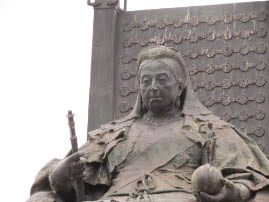
Victoria Memorial |
Thank goodness India’s government chose not to tear down these amazing buildings left behind by the retreating British. Several countries opted for destruction of the previous invaders. Victoria Memorial, a real treasure left by the Brits was re-purposed by the new India government.
We drive by of the main square in Calcutta. I am completely blown away by the aging, but grandiose structures left behind. Ray points out several buildings – what the British built them for and how the Indian government uses them today. Here I manage to snap a photo from the bus of the first British telegraph building. Today, it’s a communication center.
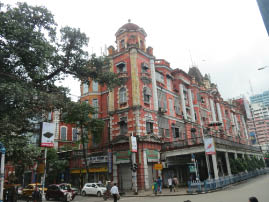
Calcutta Telegraph Building |
We also drive by the largest stadium in the world –it seats about 250,000 fans. Can you imagine the tailgate parties they must have?
My favorite stop is Mother Theresa’s room / museum – 54A, A.J.C Bose Road – Kolkata 700016. This is where Mother Theresa set up her Missionaries of Charity in 1950. For almost a half of century she worked from here caring for the sick and destitute of Kolkata (I can only say Calcutta). We see her tomb and visit the simple museum. She was from Bulgaria and became a nun when she was only 13. She was trained in nursing and started Sisters for Charity in Calcutta. I was especially struck by her room where she stayed from 1953 until her death in 1997. It contains a simple bed and a simple chair and desk. However, “no photos allowed,” so I stare at the items and try to embed then into my memory. The simplicity was astonishing.
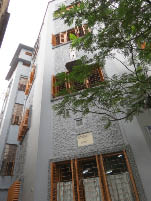
Mother Theresa |
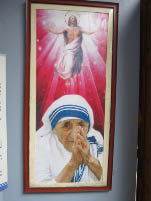
Mother Theresa |
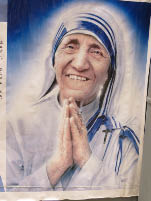
Mother Theresa |
Mother Theresa walked the streets of Calcutta giving love to the homeless. Today, the streets are packed with homeless, but Ray said, when he was growing up here, the homelessness was far worse. Ray said he saw Mother Theresa often and still misses her. Unlike the other nuns, he said that she was always smiling.
She was a small woman, but very powerful. Her quotes give insight to her philosophy of life. Here are only a few:
- “It's not how much we give but how much love we put into giving.”
- “I alone cannot change the world, but I can cast a stone across the waters to create many ripples.”
- “Live simply so others may simply live.”
- “I can do things you cannot, you can do things I cannot; together we can do great things.”
- “If you can't feed a hundred people, feed just one.”
- “If you judge people, you have no time to love them.”
We board the bus for our next stop. As we drive, I take in fascinating scenes from the large bus window as Ray points out the contrasts in Calcutta – rich and poor – slums and beauty. He is chuck full of information – like how the caste system started back in the 3rd century. The untouchable cast came about because they were the group who handled dead bodies and dead animals – and it was unhealthy to touch them. We leave the confines of the bus and walk a few blocks through a typical neighborhood. I like the experience – I can smell the smells and absorb the details.
Around a corner, we enter a Jain temple complex built to honor 12 of its prophets. Inside the temples, the walls are covered in mosaics and mirrors – beautiful and intricate. (Sorry – no photos allowed inside.) Well-kept gardens dotted with strange statues cover the Temple grounds. I could not relate to anything I saw and wonder how this place brings spiritual tranquilly to its believers. I could only marvel at its beauty and gawk at its strangeness. (Later in the trip, I would come to know more about the Jain sect -- very successful and very strange indeed – more to come.)
Our next stop is the book selling section of town. Ray quotes fact after fact of how Calcutta, poor as it is, ranks highest in literacy and top in the number of universities. An offshoot of Calcutta’s reverence for intellectual endeavors is its huge book publishing business. From the bus, we pass street after street of stores packed floor to ceiling with books. We disembark the bus to really see the area on foot. After wading through crowds of book sellers and book searchers, Ray leads us to a coffee house built 216 years ago. Here we stop for a coffee break. I feel the ghosts of the past all around as I imagine their late night philosophical conversations lite by dripping, smoking candles. Way cool.
Our next stop is the 18th century St. John’s Church, one of the earliest churches built by the East India Company in Kolkata. On our way to the church, Ray tells us about Warren Hastings, the first Governor-General of India from 1773 to 1784. He was born in England into a poor family. He came to India to work as a clerk. He was smart and hardworking and made his way up the East Indian ladder of success. He learned the religious practices (Hindu) and the languages of India, which made him popular with the “natives”.
He met and married his first wife, Mary, who was the widow of a Black Hole Massacre victim (more about the Black Hole incident later). Mary died a few years later in 1759.
On a voyage from Dover in March 1769, Hastings met the German Baroness Katherine Imhoff and her husband. Hastings fell madly in love with the Baroness who apparently was a real hottie. They began an affair, seemingly with her husband's consent. Hastings planned to marry the Baroness once she got a divorce from her husband. The process took a long time. It wasn’t until 1777 when news of divorce came from Germany that Hastings was finally able to marry her. Hastings built St. John’s Church as a proper place to hold their wedding. Ray had a lot of other stories – but my jet lagged, overloaded mind just couldn’t retain all Ray’s data.
St. John’s Church, left by the Raj in India, was built in the Neo-Classical style. The church interior has many monuments and hundreds of beautiful Anglo-Indian armchairs c. 1815.
I was fascinated by a Leonardo da Vinci-style Last Supper painted by Johann Zoffany, a British artist of German descent. Apparently, Zoffany took some liberties with the last supper scene -- like using his wife’s image leaning on Jesus’ shoulder. Because he missed this wife so much, through his painting, he could see his wife each time he attended church. He also portrayed Judas as a well-known merchant in the then-proper Calcutta Society. He got into a heap of trouble over that one. I think Zoffany’s interpretation of “The Last Supper” is stunning, far better than da Vinici’s rendition.

St. John’s Church |

St. John’s Church |
Ray took us into a room at the back at the church. It was here, on the very same table and chairs, where Warren Hastings conducted secret, cloak and dagger meetings, plotting for power and the expansion of the East Indian Trading Company. He was a very clever guy.

Where Warren Hastings Conducted Secret Meetings |
Outside, on the church grounds, we find an eclectic selection of monuments. One was the Mausoleum of Job Charnock, founder of Calcutta, which supposedly, has the oldest piece of masonry in Kolkata. Others were a memorial to Lord Curzon and the “Black Hole” memorial. I was most fascinated by the “Black Hole” memorial.
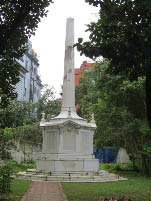
“Black Hole” memorial |
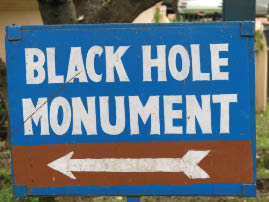
“Black Hole” memorial |
The Story of the Black Hole – Optional Reading
In 1756, Sirai-ud-daulah, the Nawab of Bengal, decided to show off his power by driving the infidel Europeans out of India. His army attacked Fort William in Calcutta and captured 146 soldiers of the British East India Company. (The East India Company set up trading posts in Madras and Calcutta. Troops were hired as company employees to protect the trading posts from restless natives and from the other European powers – such as the Dutch.)
On June 21, 1756, on the Nawab's orders, the British East India Company soldiers were marched into the "Black Hole," a prison cell located in the fort. One hundred forty-six people were crammed into a cell that was 24 feet wide by 18 feet long in the hot Indian summer. There were no windows in the room. No water or food was given to the captives. When the Indian guards returned the next morning, 123 of the 146 had died, many of them still standing up due to the crowded conditions of the room.
Anyway, that's the story told by one of the survivors, John Zephaniah Holwell, in A Genuine Narrative of the Deplorable Deaths of the English Gentlemen and others who were suffocated in the Black Hole. No other survivor of the Black Hole incident stepped forward to tell their story.
On the word of Holwell, the incident attained mythical status underscoring British stoicism for surviving the horror, and showing Indian treachery and barbarism.
Later scholars question Holwell's story. If it even occurred at all, it was greatly exaggerated. It certainly helped Holwell in an attempt to become a hero – he rose to become Governor of Bengal. Oh well, facts really don’t matter after all. Two clear examples of that today -- Tea Party and Fox News.
|
Our last stop of the day was down by the riverside, the Gange’s Riverside, that is. It is a wide river and home to lots of big boats. We watch a few souls go down into the river’s edge to purify themselves. The “River Beautification Project” restricts access to the water and forbids tossing loved ones’ ashes into the river. However, history and tradition die hard as many citizens easily break the rules. Hey, when your belief system is so strong and requires you got to get to the river to purify your soul to make it to heaven, who cares about a few silly rules. It’s clear that River Beautification Project has a very long way to go.
Ray delivers us back to the hotel neighborhood in the early afternoon – can’t believe we covered all that stuff in the morning. Based on Ray’s recommendation for lunch, we head off to find a place called Flury’s. We have some trouble finding it. It wasn’t worth the trouble because the lunch was a wimpy little club sandwich on Wonder Bread. Maryanne, a fellow OAT traveler who also hails from San Diego, joins us for lunch. She is coming down with a cold and we want to keep our distance from her.
After lunch, Maryanne goes off to find some serious drugs in India’s pharmacies while Bill and I walk back to the hotel, stopping at the hotel for 75 cent Happy Hour draft beer.
We return to the streets hoping to find access to a “fly-over” described in a tour guide – a place where one can get a great view of the neighborhood. We never found it, but many want to “Help us.” Help – Ha! After we tell them where we want to go, they ask for money and/or take us to shops, owned by relatives / friends, tucked away in some alley. The last two guys were sweet and promised not to harm us. They drag us into a dusty shop with counters stacked high with folded cheap scarves – nothing of interest to us. Bill and I are separated on the way back. I looked around and asked one of the guys if he kidnapped my husband. When Bill appears again, we all have a good laugh.
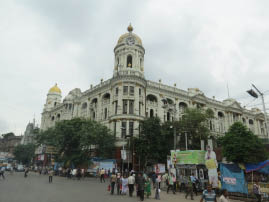
Calcutta |
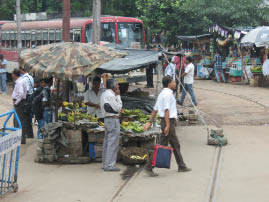
Calcutta |
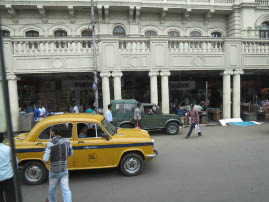
Calcutta |
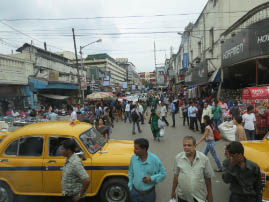
Calcutta |
We meet Maryanne at 6 pm in the hotel lobby to see if she’s feeling up for dinner. In just a few hours, she gets really sick, belting out horrible coughs. Much to our chagrin, she insists on going to dinner with us anyway. Lord have mercy -- a walking germ factory is accompanying us to dinner. Bill finds a Muslim place called Ansalom’s in our guide book. We’d forgotten that Muslim’s hash houses don’t serve alcohol and don’t have knives in the place setting. It wasn’t a pleasant dining experience. We need beer and knives! Also, we don’t understand the menu and have no clue as to what we are ordering. Maryanne keeps spewing out coughs as we back our chairs farther and farther away from the table. When the bill comes, Maryanne really questions it and gets the waiters and even the manager involved when there was nothing to question. I don’t think we left a very good impression on them as Americans. Hate when that happens. We did notice that men are always served first -- Bill likes that.
We walk back to the hotel in the crowded streets. We see lots of men out and about, but very few women. It makes me wonder if these streets are not safe for women at night. The darkness of the night doesn’t cover the squalor, it only makes it more scary – and dangerous to see where you are stepping. I step over a dead dog lying on the sidewalk. That really hit me in the gut. Don’t know why that bothered me so.
We got back to our room to pack for Bhutan. A 5 am wakeup call comes very early.
10/24/13 Calcutta to Bhutan
That 5 o’clock wakeup call comes at 4:45! Damn. We pack our bags and go to breakfast. The airport bus leaves promptly at 6 for our flight to Paro, Bhutan. Our flight is scheduled to depart at 8:30 so we have lots of time to kill in the airport.
Drukair Royal Bhutan Airlines, run by the country of Bhutan, radiates happiness. Bill and I want to get seats on the same row so Bill asks the flight attendant if he can move to another seat. With a smile from his heart, he says, “This is a happiness flight, sir. Sit where ever you’d like.” Happiness, like coffee or tea, is a real commodity served up on Drukair Air.
The phenomenal landing into Bhutan, a landlocked country high above sea level, is forever embedded in my memory. Our large plane climbs up and over the Himalayans and then straight down between two mountains over a narrow valley carved with picturesque streams and rivers. At 10, we land in the happy airport in Paro and go through happy customs and then join with Karma, the happiest of guides.
Man-oh-man – this place is something!
Karma loads our luggage onto the van and then we take off for Thimphu, the tiny capital of Bhutan. It takes an hour and a half to drive from Paro to Thimphu. The scenery through the countryside is spectacular – high mountains, rivers, rice paddies, traditional houses, farmers in their fields with no sign of billboards or roadside trash -- truly idyllic.
We stop at an overlook. Karma points out a 14th century iron chain bridge that stood the test of time. Later in the trip, we learn about the main monk, Thangtong Gyalpo, responsible for covering the country’s streams and rivers with iron chain suspension bridges.
Thangtong Gyalpo (1385-1464) – Not Required Reading
Thangtong Gyalpo lived in the 14th century in Tibet and later in Bhutan. He was a great Buddhist, a yogi, physician, blacksmith, architect, and a pioneering civil engineer. He built many iron chain suspension bridges around Tibet and Bhutan. It is said that he built 108 of these bridges. (By the way, 108 is a powerful, mystical number.)
In 1433, he came to Bhutan and found a large iron ore deposit. Like all good saints, he received a vision, namely to make it easier for people to cross rivers and gorges with the construction of iron chain bridges. So he, with the help of 18 blacksmiths from Paro, forged iron for the chain links. This area of Bhutan is more depended on bridges than Tibet. Raft or ferry connections are not possible because of the deep gorges and rushing rivers.
One more interesting fact … Gyalpo is a patron saint of Tibetan medicine, as well as the founding father of Ache Lhamo, Tibetan opera. It is said that he recruited villagers to perform opera in order to help fund and build the suspension bridges over the wide Himalayan rivers, thus allowing access by the many pilgrims to the sacred Buddhist sites.
Several of his chain links are still on bridges in use today. One of the chains is on display in the National Museum in Paro. (I get to see it later in the trip.)
|
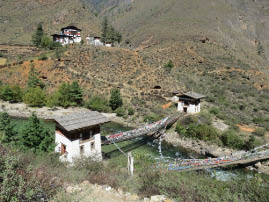
Iron Bridge |

Iron Bridge |
We have a traditional Bhutanese lunch – hardy, overcooked veggies, red rice, noodles, chicken – very fresh and very basic country cuisine. Bill and I sit with Bran and Ann. They’re both involved in an NGO in Uganda--Concern for the Girl Child.
We make a stop at Jungshi Handmade Paper – You guessed it, a paper factory. Karma shows us the intricate process of making paper. In spite of the tedious work, the factory workers seem content.
Next, we stop at the Post Office to buy stamps from some happy clerks. They take our photo to customize the stamps with our image under a Bhutanese flag. I swear Happiness is contagious and the whole country is infected.
About 3 o’clock, we arrive at Hotel Pedling located in the center of town and claim our rooms. The room is simple and nice and the views from our window are fabulous. In no time we are rattling plastic bags and putting our things away. Some of our happiness reserves are drained when we must attend to a few irritants associated with the room – a safe that’s not working and no shampoo in the room. However, the staff is happy and helpful. We shower, then do the laundry before we treat ourselves to a beer on the outside patio. (Business always comes before pleasure with us.)
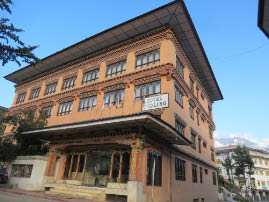
Pedling Hotel |
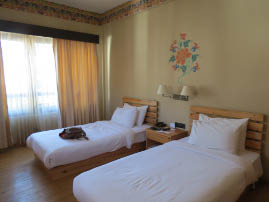
Pedling Hotel |
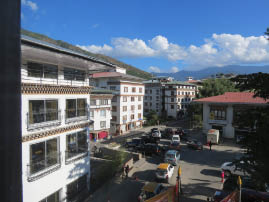
Thimphu from our hotel room |
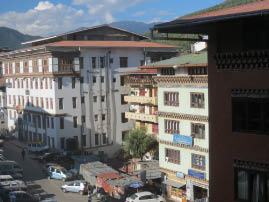
Thimphu from our hotel room |
It is a beautiful day with the perfect temperature. As the sun sets, it’s gets a bit chilly in this high mountain town. We attend Karma’s introduction meeting at 5:30 and then have dinner at 7.
At 8, I’m ready to head back to the room to do some journaling – although my poor old brain won’t cooperate – but I try anyway.
This country is like Shangri-La – as touted in the tour books … but the Hotel Pedling is a little worse for the wear. It’s run by monks who have meager needs and can’t relate to Americans whose needs and standards are tough to fill. They use the “happiness” card to try and make up the difference. Sometimes it works – sometimes it doesn’t.
10/25/13--Thimphu
By 7 we’re up and out to explore the town on foot before breakfast. I’ve not seen towns like these – all the buildings uniform and all the people are in uniform. It is nice to get a glimpse of the place as it wakes up – store owners opening up their shops and kids in the tradition garb heading to school.
We come back to the room. I write a few postcards and catch up on the journal.
SPECIAL NOTE: I just heard a crying kid from the street below. First unhappy Homo Sapien in all of Bhutan– probably some tourist kid. We only see happy faces here.
Breakfast at the hotel is OK –but not at all like The Park Hotel back in Calcutta – miss that place. We finish eating and then board the bus at 9 for a day of sightseeing in Thimphu – the tiny capital of Bhutan.
First stop -- the Memorial Stupa (Tibetan style – Memorial Chorten) built in 1974 for the country’s 3rd king – Jigme Dorji Wangchuck (1928 – 1972). He was the Father of Modern Bhutan -- an intellectual and spiritual guy who made some very clever decisions. Now there was a “Decider.” He launched an amazing tourist industry that finances much of the country’s education and health care. Each of us tourist pays an extra $250 a day to be here – and all those funds go to education and health.
King Wangchuck, “the smart decider,” died from a heart deal when he was only about 50. They tried to save him at a hospital in Egypt – but no luck. His mother built the Memorial Stupa for him. It was a cool looking stupa with lots of people and activity – people spinning large prayer wheels, old guys sitting on the lawn spinning their own little prayer wheels or counting beads, women making offerings. A couple of women are in charge of keeping the offerings in order. They watch out over two tables -- a table for fruit and another table piled high with packages of potato chips. Yoga mats line the perimeter of the temple grounds so some of the folks can jump down to a prone praying position and then jump back up, repeating the movements all over again. We march around the stupa with the crowds as Buddhist chanting permeates the air. I really get into it – like being in the middle of some National Geographic documentary. The colors that drape the stupa and the colors of the worshipper’s garb are truly a feast for the eyes.
Next, we load back into the van and drive up to the top of a hill to see the giant Golden Buddha – 169 meters, I think. He’s a brand new addition to the landscape. They’re still finishing up the project. A rich guy from Singapore paid for most of the endeavor. I wonder how many schools and how many hospitals could be funded with this money. The Buddha faces East, bringing even more happiness to the people in Bhutan. I guess it’s a legitimate way to spend one’s money. The Buddha glistens in the sunlight. He is a bit strange looking because of the red lips. I never saw a Buddha with red lips and I’ve seen a lot of Buddha’s.
Our next stop is at the Takin Reserve to see the national animal – a strange hoofed animal that befuddles scientists. Unable to relate it to any other animal, the Takin is in a category by itself –“budorcas taxicolor.” It is quite ugly and looks like part moose, part buffalo, part cow, and part goat. One of Bhutan’s favorite saints and spiritual leader, Lama Drukpa Kuenlay (1455 – 1529) AKA “Divine Madman” or “Mad Monk ,” claims responsibility for this strange beast. Known for his outrageous antics, the “Mad Monk” throws a big dinner for his followers. To everyone’s dismay, he serves cow and goat – a big NO NO in this “hands off the cow” land. He asks everyone at the lunch to leave the bones of the cow and the goat. After the guests are gone, the “Mad Monk” chants a bit over the bones and lo and behold, a Takin arises and runs to the meadow to graze. The antic works out well for the “Mad Monk.” The legend makes him very popular and Bhutan gets a new animal.
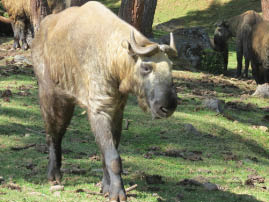
Takin |
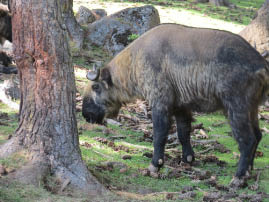
Takin |
We stop at an overlook to see the town Thimphu, the capital of Bhutan. Karma points out the main governmental buildings. The king’s palace is a modest place. But when you consider the whole country’s population is 700,000 – about half of San Diego’s, maybe the palace size is befitting of this king.
Bhutan recent history is simple with only had 5 kings – all named Wangchuck. The first king began his reign in 1907. All the kings are handsome – movie star handsome – and all very bright.
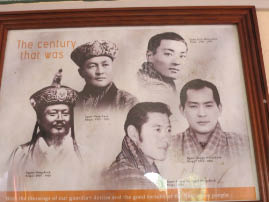
Kings of Bhutan
|
The current king was crowned in 2006. He is 33 and just got married to a beautiful 23 year old woman. They are a famous and popular couple. They mingle and interact with the people just like regular guys. She likes to play basketball. They are drop dead handsome and their pictures hang in every imaginable place throughout the country.

Royal Palace |

Royal Palace |

Royal Palace |

Royal Palace |
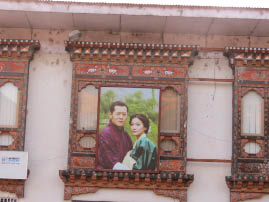
King and Queen of Bhutan |
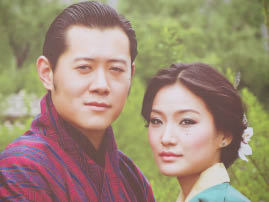
King and Queen of Bhutan |
We stop at the Royal Textile Academy and Museum founded in 2005 by her Majesty to keep the culture of textiles alive in Bhutan. The museum is a gorgeous (sorry, no photos) and the 2 floors of traditional outfits are exquisite. The current exhibit is the clothing from the Royal Family – a couple of outfits were worn by the queen during her wedding not long ago. Very nice, as one might expect. We go across the courtyard from the museum to see the academy and some weaving in action. A room of girls, each with a hand loom, is producing the most beautiful fabrics and losing their eye sight in the process. Those who do the specialized thread by thread weavings are guaranteed to go blind – a well-known fact.
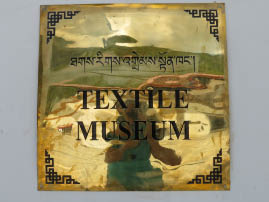
Royal Textile Academy |
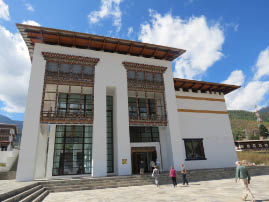
Royal Textile Academy |

Royal Textile Academy |

Royal Textile Academy |

Royal Textile Academy |
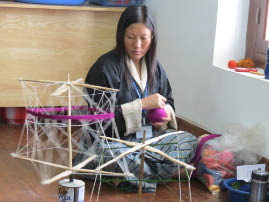
Royal Textile Academy |
Next is lunch. Over the next few days, we would grow accustom (and bored) with the typical Bhutanese food – fresh veggies, red rice, noodles, chicken, etc. Today, our basic faire is dished up by a very happy, fat waitress. She shows her heritage as she laughs from the heart.
After lunch, we visit the Zorig Chusum Crafts School – located on an old campus. Here, the budding young artists learn one of Bhutan’s 13 traditional arts – carpentry, carving, painting, sculpture, casting, blacksmithing, god and silver smithing, Bamboo work, weaving, woodturning and papermaking. In those dark, dingy rooms, we watch young artists turn out amazing work. However, the artists are not rewarded for their creativity, but for their precision and execution of following defined patterns passed down from a long tradition in Bhutan’s culture.

Zorig Chusum Crafts School |
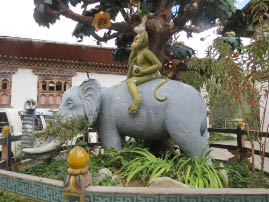
Zorig Chusum Crafts School |

Zorig Chusum Crafts School |
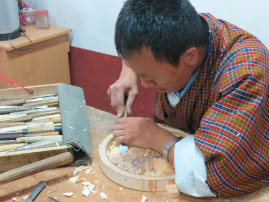
Zorig Chusum Crafts School |
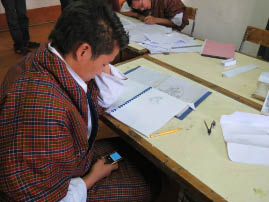
Zorig Chusum Crafts School |
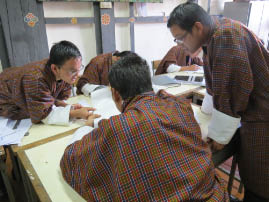
Zorig Chusum Crafts School |
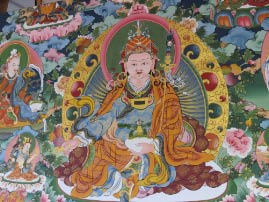
Zorig Chusum Crafts School |
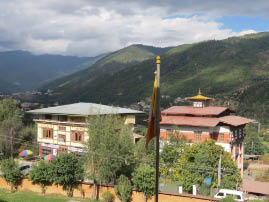
Zorig Chusum Crafts School |
We are tired and wearing down by the time we hit the National Library. It is an amazing place and holds a vast collection of ancient Buddhist manuscripts as well as the world’s largest book. Karma tries to give us the history of how this place came to hold all its treasures. I watch my fellow travelers eyes roll up as they fight off much needed sleep. I take some photos of Bill and others snoozing, just to entertain myself.
The National Library building is cool – nice wall paintings, great altars on both floors and fascinating old photographs. I am intrigued by the largest book in the world, according to Karma. We weren’t allowed to open it – that was about the only thing in the library that we couldn’t touch. You could thumb through pages and pages of ancient manuscripts – not bond, but stored on open shelving wrapped in colorful clothes. Karma pulls out one of the “books” and even reads some to us. Seeing those books gave me the biggest insight to what it must have been like here hundreds of years ago. I can just see the holy guys in their robes pouring over these books -- discussing, writing and chanting. Gives me the shivers.
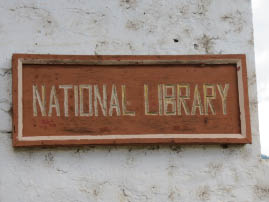
Bhutan National Library |

Bhutan National Library |

Bhutan National Library |

Bhutan National Library |

Bhutan National Library |

Bhutan National Library |
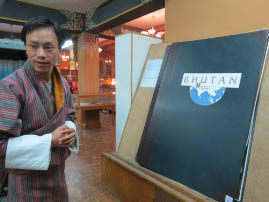
Bhutan National Library |
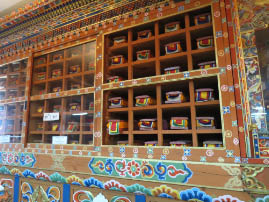
Bhutan National Library |
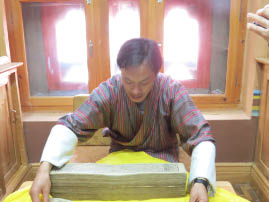
Bhutan National Library |
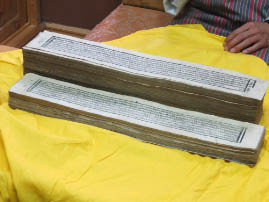
Bhutan National Library |
A souvenir shop, benefitting the blind, is our last stop of the day. I want to buy something – but am exhausted and everything looks ho-hum except the wooden penises that cover the shelves.
We come back to the hotel very tired from our full day. I shower and write today’s entry into my journal – and then declare time for Happy Hour! We have beer and dinner at the hotel. We sit by David, Judy and Ann and Bran and enjoy the conversation. It’s such a terrific group.
10/26/13--Thimphu/Travel the Dochula Pass to Punakha
After breakfast, we load into the van to travel to Punakha (via the Dochula Pass) with a few sights thrown in. The ride is scary at times because the roads are narrow and rutty, but worse yet, the van hugs the edge of the cliffs – I mean really hugs the cliffs. I’m not afraid of heights … but there were times when I had to hold my breath.
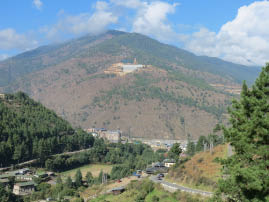
The Road to Punakha |
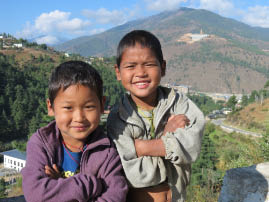
The Road to Punakha |
The van stops to let us out to explore a little stupa by the road that carries some magical meaning. Can recall its significance -- can anyone remember what the heck it is? Just curious.
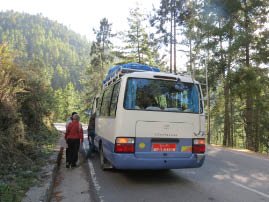
The Road to Punakha |
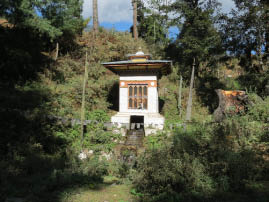
The Road to Punakha |
We reach the highest pass in Bhutan (10,000 feet) – aptly named Dochula. In Bhutanese, “Do” means rock, “chu” means water and “la” means pass. You guessed it – the top of the mountain were the three key ingredients -- rock, water and pass. We didn’t get the major impact of the panoramic view of the Himalayans because white clouds hung over the peaks – but it was still an amazing sight.
We have 30 minutes to see the two major attractions on the Dochula Pass. We start with the 108 stupas, all circling a large stupa in the center. Each stupa has a picture of Buddha on the outside and a “relic” on the inside. The stupas and the adjoining temple farther up the hill are recently constructed (2003, I believe) to honor the 4th King after he defeated some rebels from India who were making their hide-out in the south of Bhutan. (I suspect the Indian government called on the king to put an end to their nonsense. India is a good friend of Bhutan – and Bhutan needs India.) This all happened in 2003. The battle, led by the King himself, lasted only 45 minutes. Only 8 Bhutanese soldiers were killed, some more injured. But that is a hell of a victory – Wish our wars only lasted 45 minutes and our presidents would lead the troops like in times gone by. However, George Bush did put on a jump suit and posed for a photo op as a victorious leader under the gigantic sign “Mission Accomplished.” Way to go, George!
Each stupa, to be a stupa, must contain some treasure – a precious stone or some piece of antiquity. I wonder what each of the 108 stupas housed and how hard it was to come up 108 treasures and have them all properly blessed. I take hundreds of photos of the stupas – here are only a few.
After our romp through the stupas, we climb the steps to visit the temple. The temple is new, but is filled with all the old trappings of ancient temple stuff – Buddhas, altars, offerings, and wall paintings. The thing that is different about this temple is that some of the wall paintings depict the King leading the troops into the recent 45 minute battle staged back in2003. It’s amazing to see depictions of ancient battle scenes with a few fighter planes tossed in -- clever touch. Being a woman, I am not allowed to enter the small annex room next to the main area. I peer in to check out the really cool stuff. Bill is free to enter, but didn’t go in because of respect for me, I suppose, or maybe he had had enough temples.
In the main temple area, three monks sit on the floor with odd percussion instruments and chant a very haunting, hypnotic melody. They are the best monk ensemble I’ve heard to date – very professional. We use up our 30 minute time allotment quickly and have to scurry back down to the van.
The van takes us down the road a little way for tea. The place where we have tea is a café / gift shop perched high in the mountains. A large telescope, mounted by the outdoor railing, is a gift from some Japanese tourists who came to do some serious trekking and wanted to thank the host country. I don’t find anything of interest in the gift shop, or anything I can afford, so I just sit with the group and enjoy my tea and biscuits.
We drive on through the high mountains, winding through beautiful forests – starting with hemlocks, spruce, blue pines and then descend down into tropical forests and finally into the Punakha Valley. As we descend, the temperature gets warmer. I am glad that I am able to shed layer after layer. The entire day feels like we were traveling in a large national park with ever changing landscapes and weather conditions.
We stop at a restaurant in Punakha and then drive to the Punakha Dzong (temple) or Temple of Great Happiness. It sits on the spot where the two rivers merge – one male (Phochu) and one female (Mochu). Guru Rinpoche (the guy who brought Buddhism to Bhutan) predicted that a person would arrive at a place that looked like an elephant’s trunk … and sure enough, the two rivers look just like the trunk – or at least close to it. It is, however, in an ideal strategic military location – surrounded by the rivers with hills in the back. It is constructed with steep wooden entry stairs designed to be pulled up when the enemies outside decide to invade.
We cross an ancient suspended medieval bridge to reach the main door. This is a glorious temple. Yesterday I sent postcards of the place not knowing we were going to visit it. It’s huge – 600 feet by 240 feet and has a six-story, gold dome tower.
Constructed in 1637 by Shabdrung (current Buddha), it was the second dzong built in Bhutan. It was both the religious and administrative center of Bhutan until the capital was moved to Thimphu.
Before we enter the temple, Karma demonstrates how he must wear his gho (the traditional and national dress for men in Bhutan) when he enters the temple. Putting on a gho is a very complicated procedure with lots of twists and turns of the fabric before it is securely fastened over one shoulder. Women only have one narrow piece of cloth to toss over their left shoulder. I could manage that. For the men at least, colors of the gho indicate status in life -- white for the commoners with a varying range of colors all the way up to red for the top dogs.
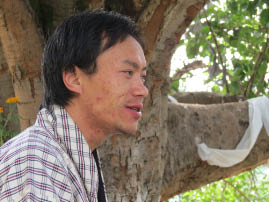
How to wear a gho |

How to wear a gho |
We climb the steep wooden steps to the temple’s front “veranda” where there are two large prayer wheels the size of huge oil drums. It’s a busy day at the temple and lots of folks take a turn at spinning the wheels. A stick attached to the top of the wheel rings a bell at every full cycle. I wait for my turn just to have a spin. Unfortunately I turn the wheel in the wrong direction which sends a once happy guard very quickly to correct my mistake. With such behavior, I could bring major curses on the whole operation.
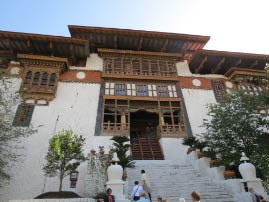
Punakha Dzong |
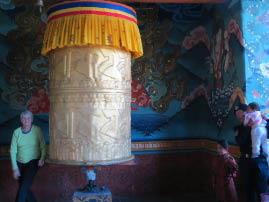
Punakha Dzong |
Next we move into the entry way where Karma explains two large murals. One depicts an old man who is thankful for longevity – although he looks pretty miserable as an old man. The other mural tells the story of four friends -- a bird, a monkey, a pig and an elephant – and how their teamwork leads to success. As the story goes, the bird finds a seed and plants it. Then, the rabbit waters it, and the monkey fertilizes it. Once the seed sprouts and begins to grow, the elephant protects it. After some time, the small plant grows into a big, beautiful tree full of healthy fruit. By working together and using their individual talents, the four friends are able to reach and enjoy the fruit. Almost everywhere you go in Bhutan, you see paintings or sculptures depicting the “Four Harmonious Friends,” popularly known as Thuenpa Puen Zhi.

Punakha Dzong |

Punakha Dzong |
My big “ah ha” is that these murals are teaching tools and have been for centuries. The monks and other holy leaders explain lessons of life to the uneducated masses with these graphic depictions. Other murals are the strange astrological charts and mystical guides for the monks to interpret and predict the future. Picking the right date to marry or build a house is still big here.
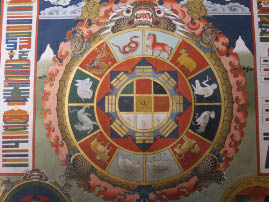
Punakha Dzong |

Punakha Dzong |
Once inside the entrance, there are 3 sections, instead of the usual two. A wonderful Bodhi tree and a bright white stupa occupy the first courtyard. The buildings surrounding this courtyard house a governmental office. The next section is the residence / apartments for the monks with two large hallways. The first king’s coronation was held in one of the hallways. The last section is the temple, called the temple of 100 pillars, although there are only 54.
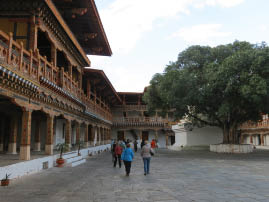
Punakha Dzong |
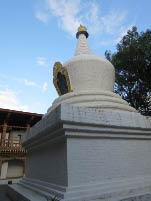
Punakha Dzong |

Punakha Dzong |
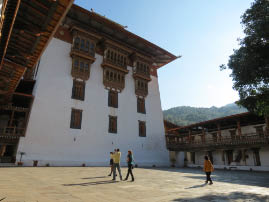
Punakha Dzong |

Punakha Dzong |
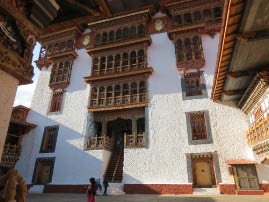
Punakha Dzong |
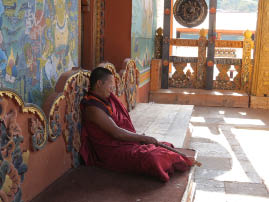
Punakha Dzong |

Punakha Dzong |
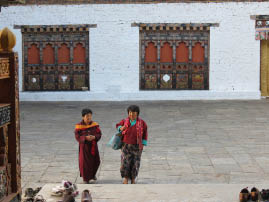
Punakha Dzong |
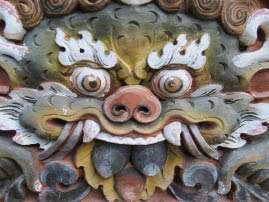
Punakha Dzong |
Karma enters the large temple and does a series of standing to kneeing positions, throwing himself on the floor to bow to Buddha or the ancient saints or to the gods in general. He also leaves money at the altar for more blessings. Karma is a very sweet, gentle person. It is fascinating to have a guide who truly believes in demons and dragons show you around. I get that people from ancient times could believe in such things– but people in 2013 seem a bit out of touch – but then again, I’m very jaded.
It is religious holiday and the temple is hopping with activity. Some families are seated on the floor just hanging out, having snacks and listening to that gosh awful chanting with even worse instrumentation. There are about 30 monks seated in the center in 3 rows on the floor. Some monks are only about 10 years old. They swarm around on the floor like any ten-year old would. The older monks are more centered and serene – takes some training to lose that kid energy and to just be still. The oldest monk, in charge, is seated in a chair looking totally bored. (Maybe I’m projecting.)
After Karma completes his personal temple rituals, he takes us aside and whispers to us who is the Buddha, who is the spiritual leader, who brought Buddhism to the country, etc. He also shows us the large wall murals depicting the life of Buddha. He has a soft voice anyway, but when he uses his temple voice it is almost impossible for me to hear a word – so I just imagine what those scary images are supposed to mean. I am very content to stand in a busy temple in Bhutan filled with color and filtered light, and serenity, and absorb what it must have been like when the place first opened in 1638. All those years of chatting and praying have left some mighty nice vibes behind.
My religious experience in the temple ended when Karma told us it was time to go back to the van. It was nice to walk back over the old medieval bridge in the footsteps of those ancient worshippers.
We drive to our hotel – Meri Puensum Resort. Man did we hit pay dirt. It’s a wonderful old resort with cottages that go up the hillside – and we are at the top of the hills with the most amazing view. I am giddy with excitement when we enter our abode. We are in the in the heart of a rice paddy. I’ve been trying for days to get the perfect shot of the perfect rice paddy – and now the perfect one surrounds me. I go from window to window to patio snapping photos. I take a shower to calm myself down and then write in my journal. I hear the cows mooing right now – what could be nicer?
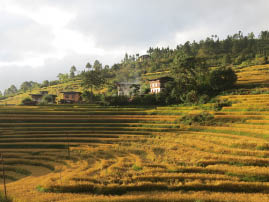
View from Meri Puensum Resort |
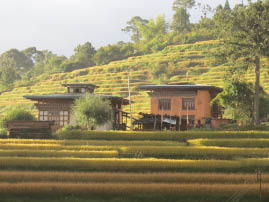
View from Meri Puensum Resort |

View from Meri Puensum Resort |

View from Meri Puensum Resort |
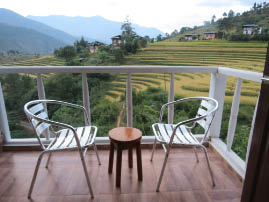
Meri Puensum Resort |

Meri Puensum Resort |
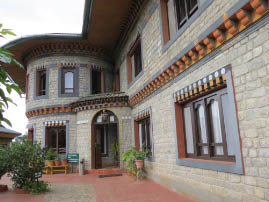
Meri Puensum Resort |
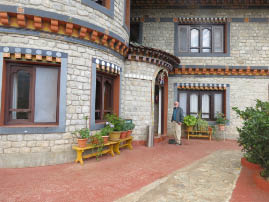
Meri Puensum Resort |
Later on … we meet in the dining room at 7. We drink a beer – and then are served the first course, pumpkin soup – very nice. The rest of the dinner is buffet – with the same menu, only this chef is a notch above the rest. We stay and talk a little with David and Judy before we head off to our heavenly room in the sky with the rice fields below.
10/27/13--Wangdue Phodrang Dzong/Chhimi Lhakhang Monastery
We wake up surrounded by the beauty of the mountains and valleys. Breakfast is at 7:30. Afterwards, I dash around with my camera documenting the scenes from the hotel and the old man turning the prayer wheel by the main gate.

Scenes from our hotel |

Scenes from our hotel |

Scenes from our hotel |
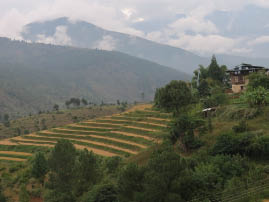
Scenes from our hotel |
This morning we head to the Chimi Lhakhang Monastery or Black Dog Monastery located in Punakha, just between Pajo and Lobeysa.
The van drops us off in a little village (Metshina) where we begin our hike to the monastery. We can’t help but notice that many of the houses and stores are decorated with large penises -- all erect, some with eyes, some with wings. Karma tells us this was a tradition because people living in the houses didn’t want others to stare at the house and talk badly of them. By drawing penises on the exterior of their houses, the would-be gossipers would look away. Now that’s a stupid ploy – I would think folks would be drawn to stare at all those penises – but hey, that’s just me. We find depictions of the penis everywhere. The phallic worship and symbology pervades Bhutan, especially when one travels towards the east, which is less developed. (Paro airport is in the west, and Thimphu - the capital - slightly to the east of Paro).

Paintings on houses in Metshina |
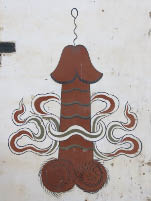
Paintings on houses |
The hike from the village to Chimi Lhakhang is short, but Bhutan's natural beauty surrounds us every step of the way. It is Sunday. We see a few people working in the in the fields. We see a lot of kids out playing – playing cards, shooting darts, and participating in some form of jump rope. We have a delightful hike through the rice paddies in a most serene place. It reminds Woo and Kai Park, fellow OAT travelers, of the time they were growing up in Korean and walked through rice paddies to get to school.

Hike to Chimi Lhakhang |
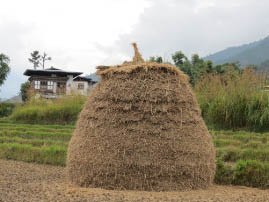
Hike to Chimi Lhakhang |
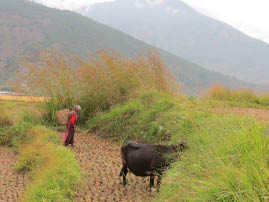
Hike to Chimi Lhakhang |
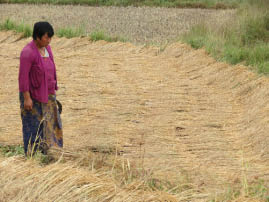
Hike to Chimi Lhakhang |

Hike to Chimi Lhakhang |
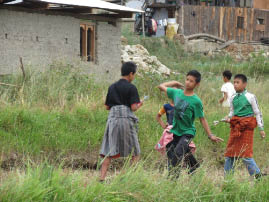
Hike to Chimi Lhakhang |
We arrive at the Chhimi Lhakhang and learn all about this very odd little monastery. We sit around a Bohdi tree and listen to Karma relate one story after another. Legend has it that the Divine Madmen, Drukpa Kinley, using his magic thunderbolt of wisdom, subdued a Black Dog Demon at this place, trapping it under a rock near where a black stupa (chorten) now stands. Of course, Karma, our guide, believes every word of the legend because he is pure of soul. Loosely translated, the temple is called “No Dog Temple,” although I see plenty of scroungy old dogs laying around.
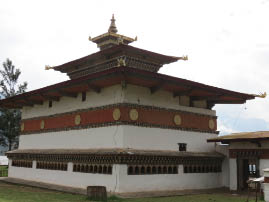
Chhimi Lhakhang |
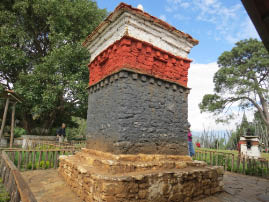
Chhimi Lhakhang |
Bhutan folks come to this temple seeking blessings from Drukpa Kinley, the Devine Mad Man, who is a real pervert by anyone’s terms. Karma tells a long story about how this crazy guy announced that he wanted to have sex with his mother. The mother was offended, but apparently her son just wanted to shake things up a little. He’s also the one who created the strange goat / cow / buffalo animal called the Takin, as reported earlier. Of course I am fascinated by such a guy. Here are the facts, not the myths, about him.
Lama Drukpa Kuenley lived in Bhutan around the 1500s. He was born in Tibet, but came to Bhutan as a great Buddhist master who ranked among the highest levels of sainthood. However, he is remembered for his outrageous teaching style delivered with sexual overtones. He thought that the stiffness of the clergy and social conventions were keeping people from learning the true teachings of Buddha. Dressed in rags, stinking of alcohol, he roamed the valleys of the Himalayas, intent on womanizing and producing countless children. During a religious ceremony, he received a blessing thread to hang around his neck. Instead, he wound it around his penis saying he hoped it would bring him luck with the ladies. During my travels in Bhutan and India, I would learn a lot about his particular sect of tantric Buddhism focusing on turning sexual energy into a transcendental experience of bliss and wisdom.
Of course, I am intrigued by the Mad Monk’s Tantric Buddhist sect and wonder about those sexy little monks. One can see why Bhutanese from all over the country come to this temple to seek blessings in fertility department or help with sexual dysfunction -- strange to our sexually repressed Western eyes. Sunday church services back home could be a whole lot more interesting if they picked up on the tantric Buddha theme here and there. I’ll be sure and google tantric when I get home.
It was a beautiful morning on the temple grounds under that Bodhi tree, but Karma’s stories went on and on. I zone out after a while and watch the young monks play soccer on the temple grounds – beautiful to see them with their flowing robes.
We make our way to the temple where a dog is laying down and blocking the main steps and will not move – and they call this a “No Dog Temple!” I buy a packet from a temple guy for my friend Ann back at home and then join our group. A monk conducts a ceremony for our group. First he pours lovely smelling water on our hands and we rub it on our heads. Then he takes an old sword that has been wrapped, relics from the Devine Madman, and taps our heads with it. There are the typical Buddha’s statues behind the altar. There is a girl goddess with offerings of barrettes clipped to her robe. Strangest of all was a statue of a guy, once a mean man / tax collector from the area, who turned good. To atone for his wicked ways, he has a statue carved of himself holding a lamp. The statue is of a pudgy naked little guy with a huge erection. I was so tempted to take a photo of this amazing figure – but restrained myself because taking pictures in the temple is forbidden. Hope his image is somewhere on the internet – (NOTE: Reporting back home, can’t find that image on the net – Darn!)
We walk back down through the rice paddies and the happy children and the scroungy dogs. We stop to visit a farmer’s house. The farmer is the cutest little guy. He’s 77 and wearing an Indiana Raceway t-shirt. He shows us around his house – first floor kitchen, bedrooms and communal area with a very nice looking altar. The simple wall paintings are a nice touch – I’m sure they have some deeper meaning.
Our aging group does some tricky climbing up narrow stairs to get to the second floor. The large room is filled with light and wonderful views of the surrounding mountains and rice paddies. I snoop through a stack of old books in the corner and find a couple on Justin Bieber. I check out a kid’s book from school – neat handwriting, all in English. Red peppers are hanging from the ceiling while on the floor shallots and onions lay drying. (By the way, red peppers are a mainstay in Bhutan. We see them drying on rooftops everywhere we go.)
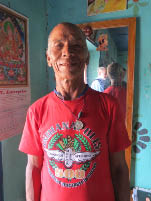
Farmer |
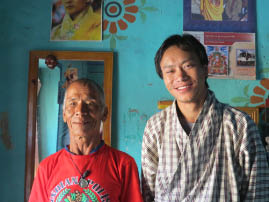
Farmer with Karma |

Farmer’s house |
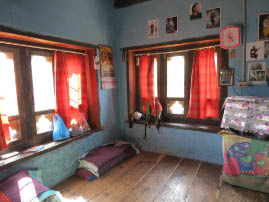
Farmer’s house |

Farmer’s house |
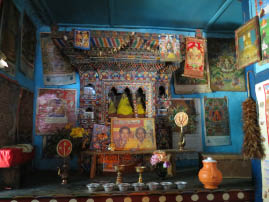
Farmer’s house |

Farmer’s house |

Farmer’s house |

Red peppers |
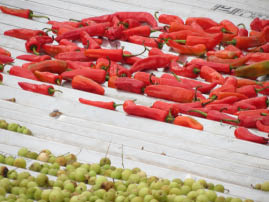
Red peppers |
The farmer shows us the huge crack in the wall from the 2009 earthquake. He spoke no English – but it is clear to all of us what he is saying. The house was built by his father. It’s now subdivided up between the farmer and his brother. The farmer renovated the house. I don’t recall how many children he has. One of the famer’s sons was once a monk, but quit to become a dancer. I’ll always remember the farmer’s smiling face – comes with the happiness territory in Bhutan – and I’ll always remember those scary stairs we all struggle to climb while that old 77 year-old farmer flew up and down the stairs like a teenager.
We leave the farmer’s house to hit a few souvenir shops on our way to lunch. The hot items are colorful drawings, carved wooden penises of all sizes, prayer wheel, textiles – scarves and jewelry. Nothing spoke to me – and everything seems a bit pricey.
We eat lunch at a nice, friendly place that continues the penis theme of the region. I notice the carved penis door handles and a large penis at the entrance – here I’m posing with it. The lunch menu is the same since we hit Bhutan – red (or white) rice, noodles, chicken thing (where you can’t recognize the pieces of meat), veggie dish (always featuring green beans), and some spicy thing. I’m having more veggies than I thought possible – that’s a good thing. Today, for dessert, we eat ice cream – a reminder of home and a real hit. We all go away very satisfied!

Nancy at the restaurant |
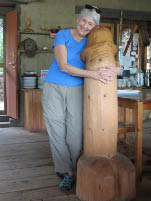
Nancy at the restaurant |
After lunch, we drive to Wangdue Phodrang and view it perched on a high cliff overlooking the river and valley below. It was once magnificent temple (Dzong) built by Shabdrung in 1638. The giant walls follow the contour of the mountain. Reconstruction was almost complete when a massive fire took the whole structure – heartbreaking for Bhutan. This was one of the 3 main dzongs in the country.
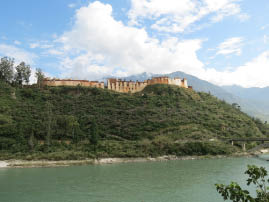
Wangdue Phodrang |

Wangdue Phodrang |
We drive a little farther to view a 400 year-old town, built down the road a bit and across from the burnt out old temple. The town sets nicely on a hill. A new town was built on the next ridge over and boy, does it look sad – boring structures with no soul. Take my advice Bhutan and don’t be building anymore new towns.
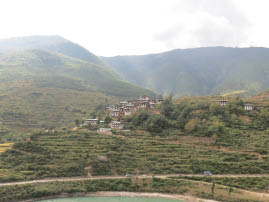
400 year-old town |
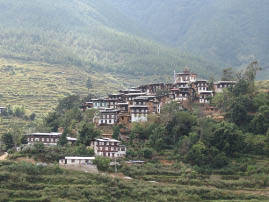
400 year-old town |
The scenery from the van window is sensational – passing over mountains, crossing bridges and driving through valleys. It is truly a Shangri-La.
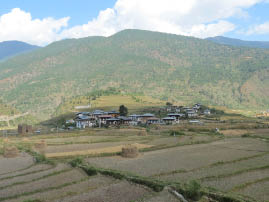
Scenery from the van |

Scenery from the van |
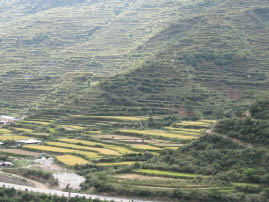
Scenery from the van |
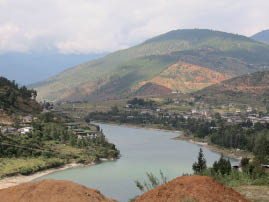
Scenery from the van |
The last stop of the day is the Sangchen Lhuendrup Choling Nunnery (in Punakha). It opened in 2010 and was built by the King's maternal grandfather. That grandpa happened to be the father of 4 queens. His 4 daughters were all wives of King Wangchuck #4 – and all married on the same day at the same wedding. The builder grandpa was very clever and became a successful industrialist. He made sure his daughters were educated – and it paid off in queens – he he. We could see his palace right outside the gates to the monastery.

Sangchen Lhuendrup Choling Nunnery |
The monastery sits regally on top of a hill with vast views of the grand valley and rivers below. One stupa is perfectly situated on the hill – another stupa is large with scary eyes painted looking down at you from the top. Surrounding the perimeter of the “scary eyes” stupa are lots of figures in alcoves – all painted black, except for their faces. The nuns who run this place make sure to have fresh marigolds adorn the stupa. Marigolds are the flower of choice to leave at the altar.
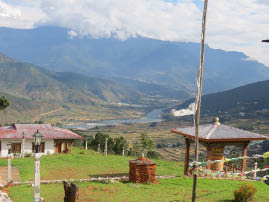
Sangchen Lhuendrup Choling Nunnery |
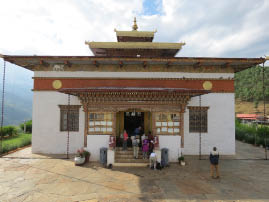
Sangchen Lhuendrup Choling Nunnery |
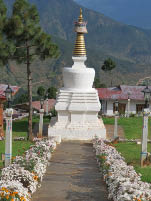
Sangchen Lhuendrup Choling Nunnery |

Sangchen Lhuendrup Choling Nunnery |
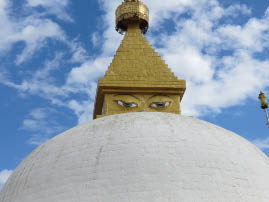
Sangchen Lhuendrup Choling Nunnery |
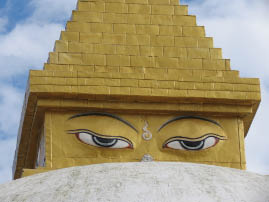
Sangchen Lhuendrup Choling Nunnery |
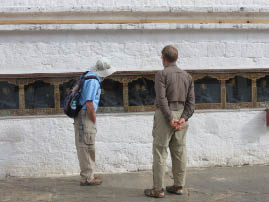
Sangchen Lhuendrup Choling Nunnery |
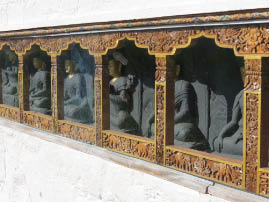
Sangchen Lhuendrup Choling Nunnery |
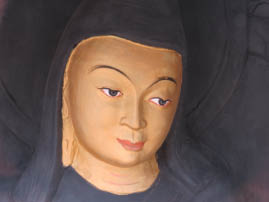
Sangchen Lhuendrup Choling Nunnery |
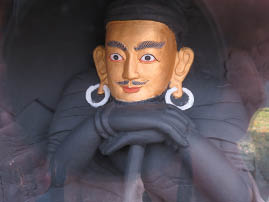
Sangchen Lhuendrup Choling Nunnery |
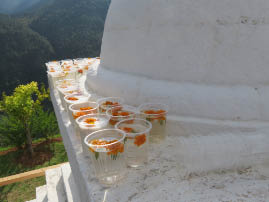
Sangchen Lhuendrup Choling Nunnery |
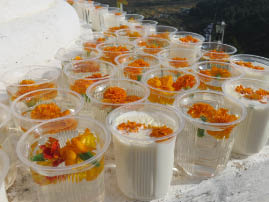
Sangchen Lhuendrup Choling Nunnery |
We remove our shoes to enter the temple. No expense was spared in the paintings, statues and other standard temple accoutrements. The big Buddha’s and other key figures were all done in bronze. Other temples can only afford clay. Large flower arrangements surrounding the altar are carved from wood. The central figure is the god of compassion with its 4 or 5 heads stacked up, surrounded by its 1,000 arms and hands. Each hand has an eye in the center of the palm. The wall paintings are eye popping. The temple reminded me so much of the styles in Cambodia with slim, sexy Aspara dancers and fat, happy Buddha’s. At the back of the temple is a large throne-like chair dedicated to the current king, I believe. Wish I could have taken some photos and saved you from wading through this long description.
Prayer flags are strung all around the area. As we are leaving, a strong wind came up – must be a storm blowing in. The prayer flags dance even more vigorously adding nicely to the mystique.
We arrive back at our hotel – our wonderful hotel about 3:30 in the afternoon. We enjoy tea and cookies in the outside lounge and then go to our rooms. The wind picks up. I settle in to write the journal and watch the sky turn gray and ominous and then comes the rain, heavy at times, but always wonderful. Hope it blows itself out tonight. Love it here!
Time for dinner …. Tonight is mushroom soup followed by another nice buffet dinner. The place is packed with a REI trekking group.
We stay after dinner to chat with Woo and Kai – Lovely people … lovely place.
10/28/13--Punakha/Paro Dzong
We drive to Paro through Thimphu, stopping again briefly at the Dochula Pass. A few days ago it was bathed in glorious sunlight – with clouds covering only the distant Himalayans. Today is a different story – socked in with fog. However, I do manage to catch a glimpse of the distant mountains through the clouds. We stopped for tea at the high mountain pass with the most expensive souvenirs in the world.
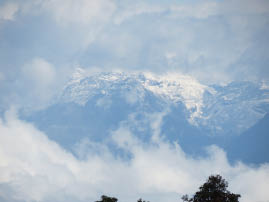
Distant Himalayans |
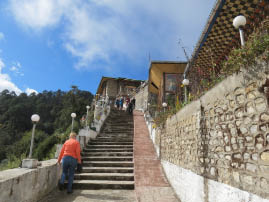
Dochula Pass |
The sun shows its face again just after the beyond the Dochula Pass. Weather is constantly changing here with so many high mountains. As we drive down, the mountain wall blocks the fog and gives us a nice view of the tropical jungle. Karma stops to show us a shrubby little Daphne tree that is boiled down and made into paper. Later, the bus driver spots a Gray Languor monkey sitting patiently in a tree. The driver has a “good eye” and that’s a good thing.
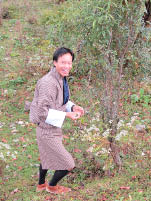
Karma |
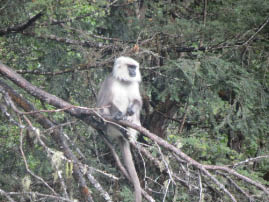
Monkey at Dochula Pass |
Our driver is excellent at navigating these narrow, winding, potholed roads. The switch back road hovers along the hillside on one side and the ridge on the other, always going up or down. I sleep much of the time – along with most of my other traveling buddies – but I do manage to catch a few shots from the van. ;
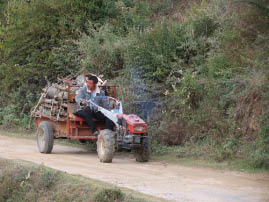
Road to Paro |
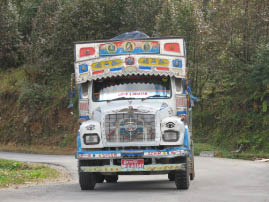
Road to Paro |
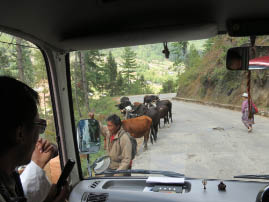
Road to Paro |
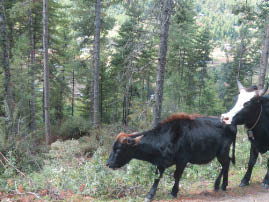
Road to Paro |
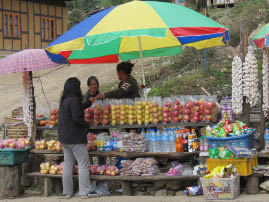
Road to Paro |
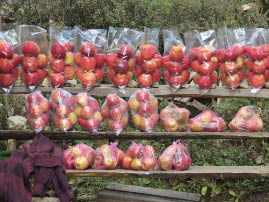
Road to Paro |
We cross a bridge where the Paro Chhu joins the Wang Chhu. A place where two rivers joined is called Chhuzom. Karma tells us this confluence is considered the union of a father and mother river. Paro Chhu represents the father and is sometimes called the Pho Chhu. Wong Chu represents the mother. Because Bhutanese traditions regard such a convergence of rivers as an unfavorable spot, there are three chortens (stupas) built here to ward off evil spirits. Karma painfully explains that each chorten is in a different style – Bhutanese, Tibetan and Nepali. Now I don’t recall which is which. (Hey – that’s what the Internet is for.)
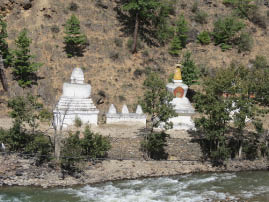 Chhuzom Chhuzom |
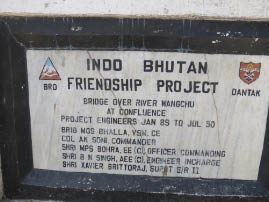
Chhuzom |
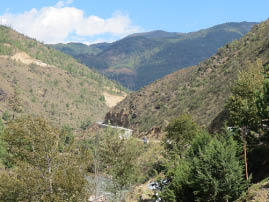
Chhuzom |
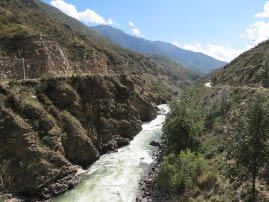
Chhuzom |
There’s a lot of construction on the road. The workers are moving boulders and bringing up fill dirt without the aid of heavy machinery. Every road crew has about 3 or 4 women moving rocks and spreading the dirt. They work hard.
The drive through the countryside is beautiful. Karma excitedly stops the bus to show us that Bhutan’s farming is becoming mechanized. There is one lone thresher down below in a huge valley of rice fields, (Sorry, didn’t get a good shot of it.) Karma was pretty excited about the progress.
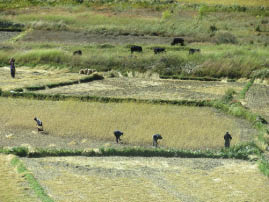
Farming in Bhutan |
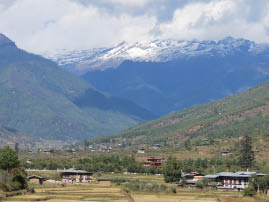
Arriving in Paro |
We arrive at Paro, the town where the international airport is located (and town we flew into a few days ago). We drive by the landing strip surrounded by mountains and farmlands below. We must drive an extra 45 minutes around the town because the bridge to the town is restricted to vehicles under one ton. Although the road is bumpy and slow, I rather enjoy the ride through the sun lit valley with the cows coming home (from the field) and the kids coming home (from school).
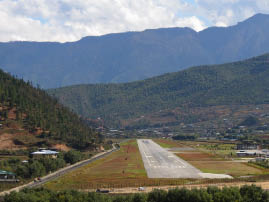
Runway at Paro Airport |
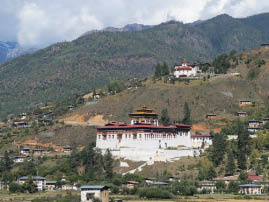
Paro |
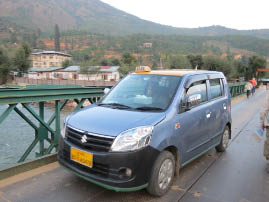
Paro |
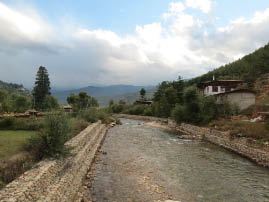
Paro |
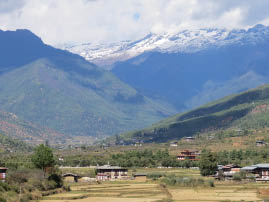
Paro |
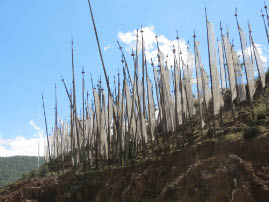
Paro |
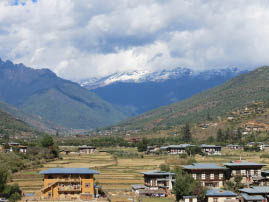
Paro |
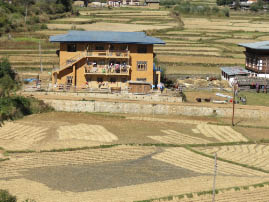
Paro |
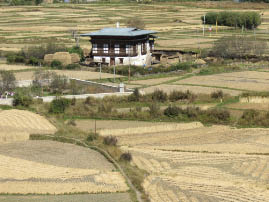
Paro |
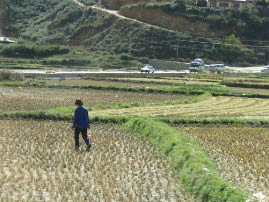
Paro |
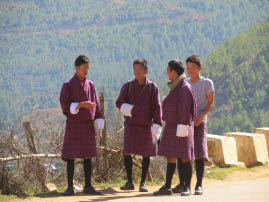
Paro |

Paro |
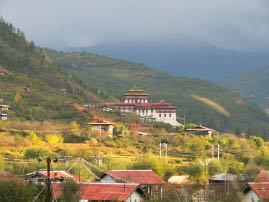
Paro |
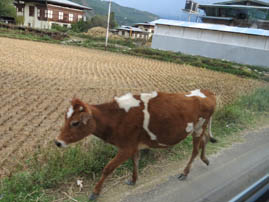
Paro |
We drive to downtown Paro. Although Paro is home to a major Bhutan airport, it is nothing more than a little podunk town where the animals happily roam the streets. We eat lunch at a typical Bhutanese restaurant – where the cuisine and the dining rooms look all the same over the entire country – simple and sweet – and now, a little tiring.
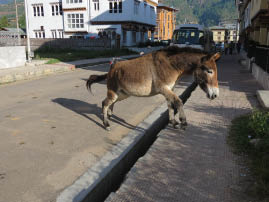 Downtown Paro Downtown Paro |
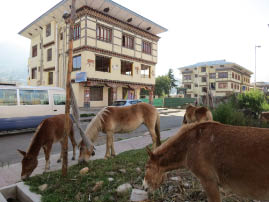
Downtown Paro |
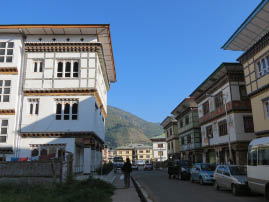
Downtown Paro |
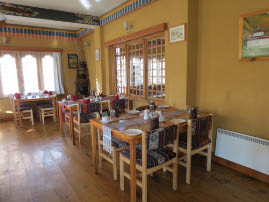
Our Restaurant |
After lunch, we visit the National Museum / Watch Tower. The collections were once housed in the old round Watch Tower, originally completed in 1656 to protect Paro Dzong below from repeated invasions from Tibet. The Watch Tower is a round building, built in the shape of a conch shell, and said to have an underground tunnel leading to the water supply below.
The museum was moved temporally to a building above the Watch Tower while the Watch Tower is being renovated. No photos are allowed – so I must rely on my fading memory. I recall passing through rooms of weapons (always big in any country’s history), musical instruments, clothing, masks (a most colorful room), and a section in the basement of natural history displays including stuffed animals (once real) and geological treasures. In one bland display case, I see a 5-inch iron chain link section forged by Thangtong Gyalpo, Buddhist monk from the 14th century who covered Bhutan with iron chain link bridges. I study it closely because no photos allowed. Don’t know why this monk and his bridges fascinate me so.
Finally, Karma ends his yammering and we are released from the dusty rooms of museum displays to go outside. We walk down a little hill to get a closer look at the old Watch Tower and the magnificent views of Paro below.
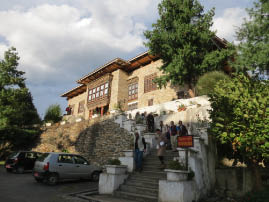 Museum Museum |
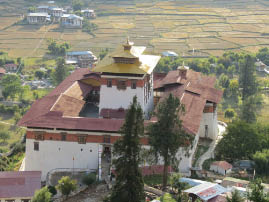
Paro Dzong |
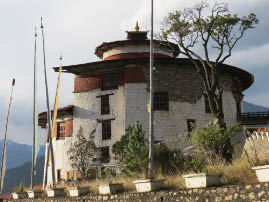
Watch Tower |
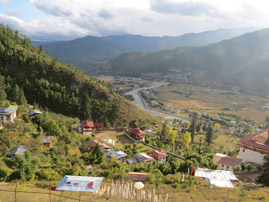
Paro Valley |
Our day of touring is over and we head to our hotel, located right next to the airport. Hotel Tashi Phuntshok is a miserable excuse for a hotel. Trip Advisor ranks it #16 of 22 in Paro, which is very generous. Everyone struggles with something -- getting hot water for a shower, getting light bulbs changed, getting wifi to work, getting the basic supplies – shampoo, soap, etc., getting someone’s attention and most importantly, getting a beer at the bar. After a long time, Bill successfully pleads our case and we are able to change rooms. However, that doesn’t solve the problems when all the rooms are in serious need of repair.
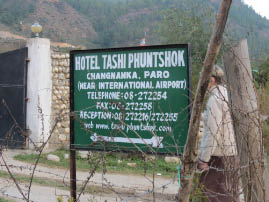
Hotel Tashi Phuntsho--Don't stay here |
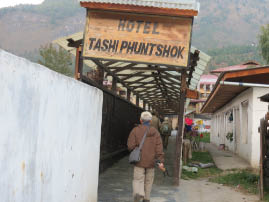
Hotel Tashi Phuntsho--Don't stay here |
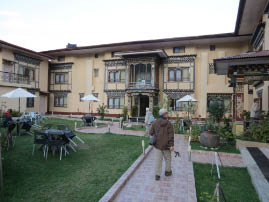
Hotel Tashi Phuntsho--Don't stay here |
We have dinner in the hotel’s dungeon basement. There are no windows and the buffet line is most dreary. We are not happy campers paying OAT prices for such a joint. We return to the room to organize our stuff for tomorrow’s big hike to the Tiger’s Nest – the highlight of Bhutan. I worry that I did not pack enough warm clothes and I’ll be cold. I also worry that I didn’t bring hiking boots and that my TEVA’s won’t be sturdy enough – all these worries are for naught because the next day turns out to be an ideal day to climb to the Tiger’s Nest.
For most of the night, we listen to a loud, ruckus in the courtyard below with lots of drinking and celebration. What’s there to celebrate around here? So much for Bhutan’s Happiness quotient!
10/29/13--Paro/Tiger's Nest Lookout/Kyichu Lhakhang
We have an early breakfast in our sorry hotel’s basement. The highlight of the breakfast is the white toast – give me a break!
We leave the hotel behind as we board the van and head to the Tiger’s Nest. It’s our favorite day in Bhutan – the day we climb to the Tiger’s Nest Monastery or Taktsang Monastery. You cannot believe there is such a place. It’s a beautiful monastery perched precariously on the side of a mountain 3,000 feet (or is it meters) above the valley floor. It looks like it was built into the mountain itself!
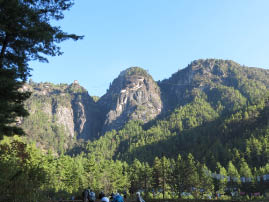 View of Tiger's Nest Monestary View of Tiger's Nest Monestary |
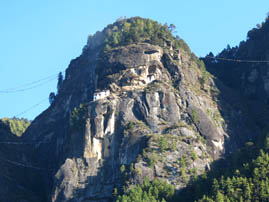
View of Tiger's Nest Monestary |

View of Tiger's Nest Monestary |

Tiger's Nest Monestary |
Taktsang is a pilgrimage for locals, seeking blessings. One local tells Judy it is the spot to go to get healing for your knees. (Believe me, you’ll need it after you’ve done this hike!).
Legend has it that Guru Rinpoche (Guru Padmasambhava) flew from Tibet to the site of the monastery on the back of a tigress (guess he didn’t have to do the hike). Here, back in the 8th century, he meditates in a cave for three months, three weeks, three days, and three hours. He is the one credited for introducing Buddhism to Bhutan. Tiger’s Nest monastery was built around the cave site later in the 17th century. It’s just plain spooky to see that the area, from a distance, looks just like the face of a tiger – or maybe it was tigress in those days.
The adventure starts when we arrive at the parking lot, which seems far away from the Tiger’s Nest mountaintop monastery since you can still barely see it! On our way to the trailhead, we see many vendors selling Bhutanese crafts and horses waiting to give tourists rides up to the monastery. We’re tough – no stinking horses for us!
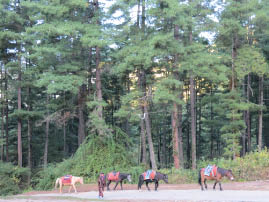 No stinking horses for us No stinking horses for us |
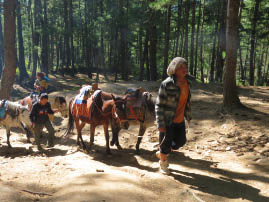
Horses are for wimps |

Souvenirs |
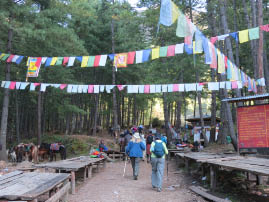
Starting up |
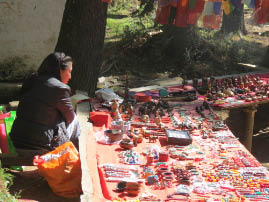 Souvenirs Souvenirs |

Souvenir seller and son |
The hike to the top is a steady, uphill climb for 1.5 to 2 hours. The first part of the trek goes through forests, but once we’re out of the forests, we quickly gain altitude. At some turns along the way, there are spectacular views of Paro below and glimpses of Tiger’s Nest above, which still seem so far away!
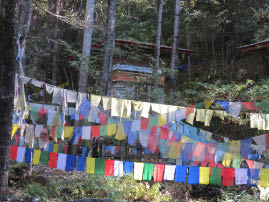 Hike to Tiger's Nest Hike to Tiger's Nest |
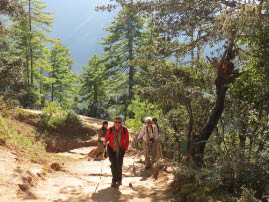
Hike to Tiger's Nest |
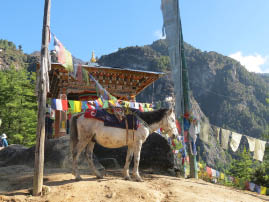
Hike to Tiger's Nest |
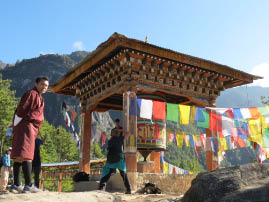
Hike to Tiger's Nest |
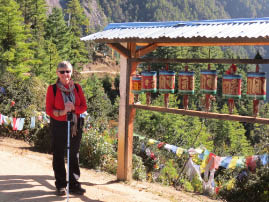 Hike to Tiger's Nest Hike to Tiger's Nest |
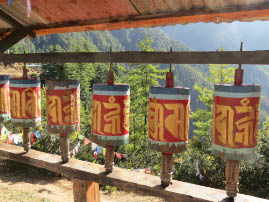
Hike to Tiger's Nest |
After 45 minutes, we come to the first stop -- a “café” – where we have some tea and our first truly awe-inspiring glimpse of Tiger’s Nest.

Hike to Tiger's Nest |

Hike to Tiger's Nest |
After tea, we continue on our steep climb. We pass by random shrines along the way. Strange objects decorate some of the shrines. There are also money (offerings) and pictures of monks tucked behind little windows.
 Hike to Tiger's Nest Hike to Tiger's Nest |
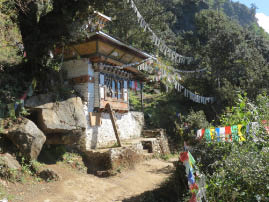
Hike to Tiger's Nest |
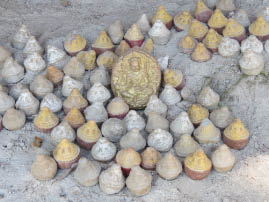
Hike to Tiger's Nest |
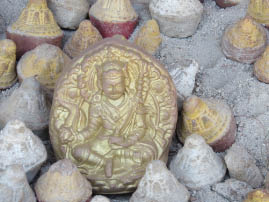
Hike to Tiger's Nest |
The second stop is the last “official” picture opportunity of Tiger’s Nest. It is exciting to finally feel we’re within striking distance of the monastery. It’s tempting to stick around and snap lots of pictures. However, Karma tells us a better picture-taking spot is still to come. And he is right – we get an unobstructed view of the monastery. Karma takes our picture. Thanks Karma, you’re a very good photographer.
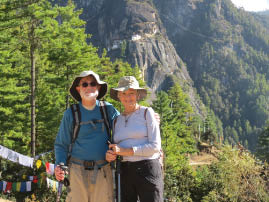 Hike to Tiger's Nest Hike to Tiger's Nest |
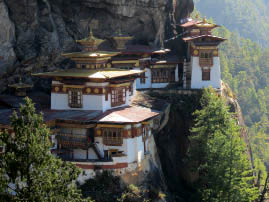
Tiger's Nest |

Hike to Tiger's Nest |
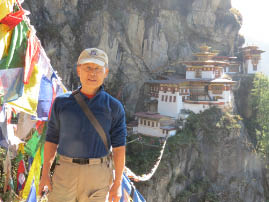
Wu on the Hike to Tiger's Nest |
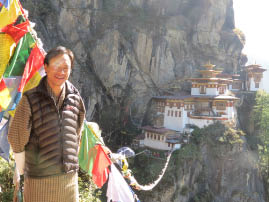 Karma on the Hike to Tiger's Nest Karma on the Hike to Tiger's Nest |
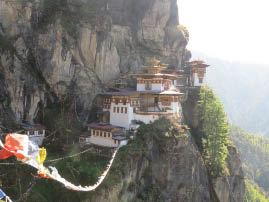
Tiger's Nest |
In the last third of the trail leading up to the monastery are 850 steps (both up and down) that you have to climb before you get to the entrance. Along the steps are the ever-pervasive prayer flags. Since the Tiger’s Nest is a pilgrimage site, tons of people come to string up prayer flags. In Bhutan, people are allowed to hang prayer flags anywhere they like. What better spot for prayer flags than at Tiger’s Nest where you’re 850 meters up from the Paro valley floor and there’s almost always a slight breeze blowing to carry the prayers in the wind?
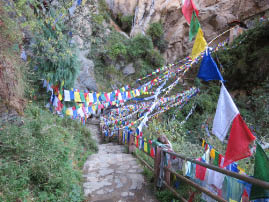 Hike to Tiger's Nest Hike to Tiger's Nest |
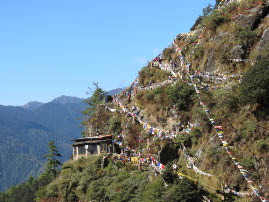
Hike to Tiger's Nest |
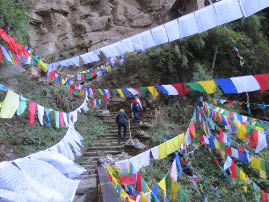
Hike to Tiger's Nest |

Hike to Tiger's Nest |
When you’re almost there, you’ll see a waterfall, a magnificent waterfall, to the left and a short bridge to cross. After the bridge it’s just 2-5 minutes of uphill steps and then you’re at the entrance.

Waterfall |
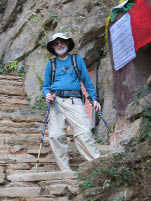
Hike to Tiger's Nest |
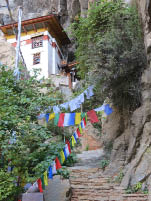
The last few steps |
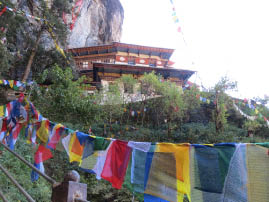
Hike to Tiger's Nest |
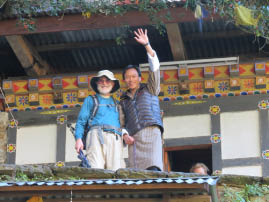
Bill and Karma at Tiger's Nest |
When you’ve arrived at the entrance, you can’t take any more photos. We must put our belongings into a locker -- backpacks, cameras, phones, scarves. Security guards are on hand to make sure you don’t sneak anything in.
The main building was destroyed by fire in April 1998, but restored to its former glory. We spend about 45 minutes checking out the inner sanctum of the Tiger’s Nest. Each of the rooms is ornate and decked out with images of Buddhist deities and fresh offerings of food and flowers, and, of course money. Everywhere, we hear monks chanting and smell the incense burning. The spirituality of the monastery is omnipresent – so much so that in one temple I make Bill sit down on the floor with me and join in the ceremony. My knees are sore so I give a silent prayer for healing. Between Advil and monk blessings, maybe I can get down this hill!
The monks’ chants are very soothing. I notice that the head monk is sleeping. Karma said that he’s not sleeping – he is transcending to some lala land. In spite of my cynicism, it is hard not to feel overwhelming spirituality in this “real life” sacred monastery. Feeling the lingering vibes of ancient pilgrims, witnessing a precarious architectural endeavor, and seeing the views of Paro along the way were all worth the climb. This is a definitely MUST DO!
We say good-bye to the Tiger’s Nest, gather our belongings from the locker and head back down the trail. The downhill trek is a serious trek since the decline is steep. My camera really got a workout today! I am powerless over all the pictures I’m snapping.
 Tiger's Nest Tiger's Nest |
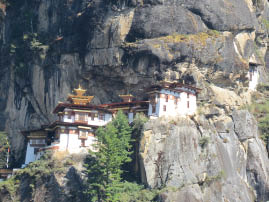
Tiger's Nest |
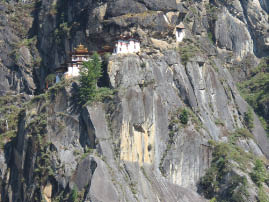
Tiger's Nest |

Waterfall |
We stop at the same café again for pee and tea, in that order. We hang out enjoying the magnificent views of the Tiger’s Nest -- a place high up in the mountains where we were only an hour ago. Maryann’s backpack is left in Kai’s care. We wait with Kai and others for Maryann to return, but to no avail. Finally, the last of the group divides up Maryann’s belongings from the pack to share the load down the hill and back to the parking lot. We find Maryann at the bottom of the trail, on a log waiting for her stuff to be lugged back down. How does she manage such things?
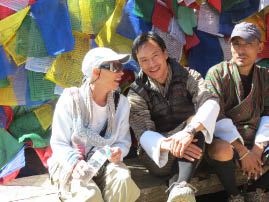
Marryann and Karma |
By the parking lot, among the tall pines, a lovely catered picnic awaits us – beer and all. The food is great, served by a lovely woman and her crew. She owes a restaurant in Paro. We all leave fat and happy with memories of the glorious hike to the Tiger’s Nest.
We drive to the upper Paro valley. The road was once an important trade route to Tibet and also the place of several invasions.
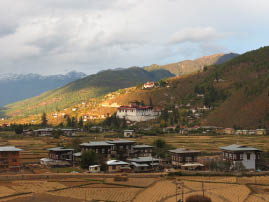
Paro Valley |
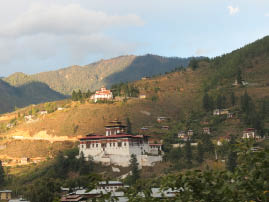
Paro Valley |
We stop at one of Bhutan’s oldest and most sacred shrines - Kyichu Lhakhang. The original site started back in 659 AD. Kingdoms back in those times, driven by mystics and power, were obsessed with the number 108 and demons that must be put down. Given those factors, King Sontsen Gampo of Tibet had to subdue a gigantic ogress (a large female monster) that covered Bhutan and most of eastern Tibet. He “built up” (as Karma would say) a series of 108 temples over the giant ogress’s body. The temple we see today happens to pin down the left foot of the monster. Cynical me believes that the 108 temples were built to protect the precious trade route – forget about pinning down the monster.
Kyichu Lhakhang is composed of twin temples -- the first official temple was built by Buddhist Tibetan King, Songtsen Gampo in the 7th century. About 1300 years later, the latest addition was built in the same style. Back in 1968, the Queen Mother of Bhutan (the third king’s wife, Ashi Kesang Wangchuck.) went with the 7th century look for her new temple. (It’s like that in Bhutan.)
The temple grounds are surrounded by a white wall and dotted with orange robbed monks. The place has a lovely feel about it. In the inner courtyard, Karma bumps into a cousin of his, whom he calls “my brother” – sweet touch. We enter the temple – the old section first. Karma goes into his quick little bowing routine and then points out the key statues and murals depicting gods, warrior-kings, demons, and Buddha’s (along with their various reincarnations to follow).
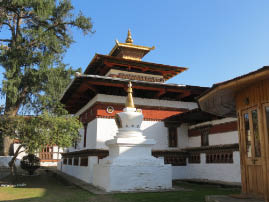 Kyichu Lhakhang Kyichu Lhakhang |
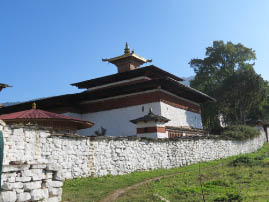
Kyichu Lhakhang |

Kyichu Lhakhang |

Kyichu Lhakhang |
 Karma and his brother Karma and his brother |

Kyichu Lhakhang |
A senior monk gets the key to let us see the latest temple, built in 1968. It is spiffier, but has the same temple paraphernalia as the earlier temple. A large statue of Guru Rinpoche dominates the room. He is a most popular statue. He’s the clever guru, with the help of this “consorts” – his 2 wives – who translated the old Buddha documents to make them apply to the 16th century world and thus brought Buddhism to Bhutan.
Next to the great Guru statue is a chorten (small stupa) containing the ashes of Dilgo Khyentse Rinpoche. To the side is a statue of him sitting peacefully in a chair. He was the Queen’s spiritual teacher and Buddhist master. Obviously, the queen adored him. The queen died in 1992 and was cremated nearby.
Karma pointed out the Red Tara -- a statue holding a bow and arrow made of flowers. Red Tara is a deity that is worshipped by unhappy lovers. Because of his (or maybe it’s a her) sensual and seductive powers, they can make the objects of desire come under their spell. Unfortunately, during his long explanation, I am in the most desperate need of a potty. After all that water on the morning hike and the beer at lunch, my bladder had maxed out. It takes a lot for a gal to ask a monk for a toilet, but I did. The monk led me down muddy hillside to a series of portal potties made of tin. I find the most disgusting literally shit hole in the universe. It is tolerable because it’s located in the center of a cow pasture. The cow manure softens the stench from years of human excrement. I listen to the cows mooing as I do my business.
I climb back up the muddy hill and find the group circling the grounds. We load back on the van and have a beautiful trip to our last destination of the day. I frantically snap pictures thinking I haven’t adequately documented the beautiful people of Bhutan.
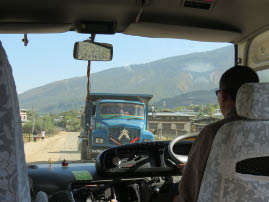 Road to Paro Road to Paro |
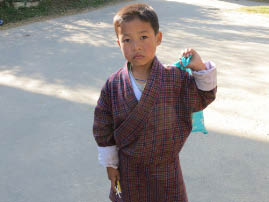
Road to Paro |
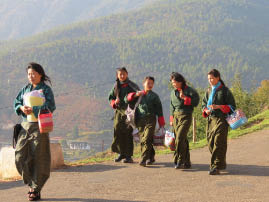
Road to Paro |
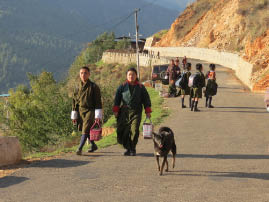
Road to Paro |
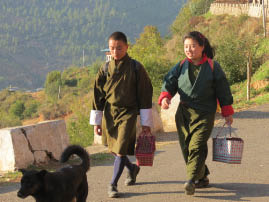 Road to Paro Road to Paro |

Road to Paro |
We arrive at our last dzong of the day and our last dzong in Bhutan -- Rinchen Pung Dzong, meaning fortress on a Heap of Jewels. This very impressive fortress was built in 1644 on the ruins of a monastery built by, you guessed it, Guru Rinpoche. It was used many times to defend the Paro valley from invasions by Tibet – using catapults for throwing great stones over the wall. It was once the meeting hall for the national assembly, but now, like most dzongs, it houses both the religious / monastic body and district governmental office, including the local courts. Bertolucci’s 1995 film, “Little Buddha,” was filmed here.

Rinchen Pung |
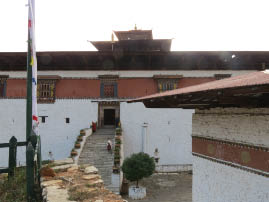
Rinchen Pung |
The dzong is built on a steep hillside, so those of us who trekked to the Tiger’s Nest must face many more steps– but it was well worth the effort.
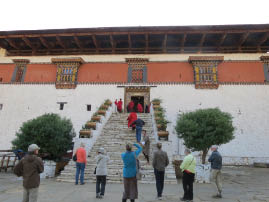
Rinchen Pung |
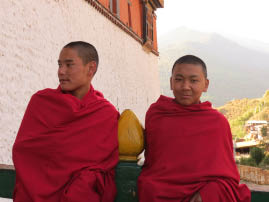
Rinchen Pung |
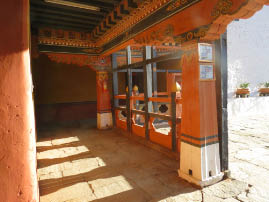
Rinchen Pung |
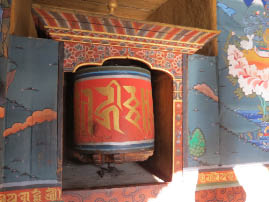
Rinchen Pung |
We have become accustom to the murals found in most entryways – the old guy grateful for longevity, the elephant / money / pig / bird and the fruit / the wheel of life and other diagrams. This dzong has the wheel of “being stuck” in the miserable life. Three animals drive the center of the wheel – the snake representing evil, the rooster representing desire and the pig representing ignorance. As long as we keep these emotions in our life, we’ll never escape. Karma spent a lot of time on the lecture – a bit of a sermon for all of us.

Rinchen Pung |
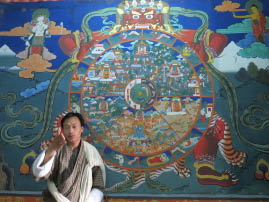
Rinchen Pung |
We leave the entry hallway and roam through a couple more massive courtyards separated by large, ornate buildings gleaning in the late afternoon sunlight. The most impressive central tower is 5 stories tall and built around 1649 – a testament to lots power and wealth going on in this area in the mid 1600’s. Another series of stairways take us to the monk quarters, now home to some 200 monks.
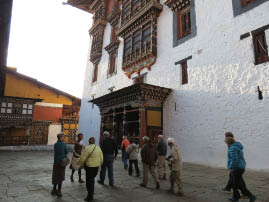 Rinchen Pung Rinchen Pung |
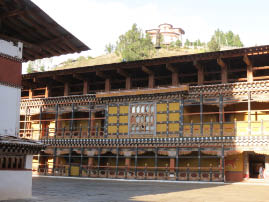
Rinchen Pung |
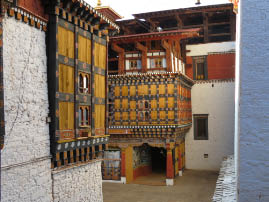
Rinchen Pung |

Rinchen Pung |
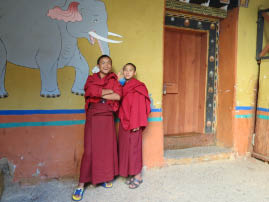 Rinchen Pung Rinchen Pung |
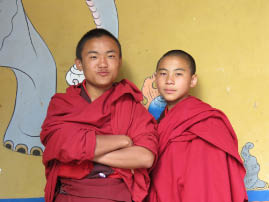
Rinchen Pung |
We enter the large prayer hall to find about a dozen young monks, around 7 – 10 years old, running and playing and acting their age while their flowing robes accentuate every spirited move. They were beautiful to watch. The floors were well worn, smooth planks of pine. It’s a joy to feel the ancient floor under my bare feet.
The main altar is as elaborate as all the others we’ve seen. The artificial flowers do take away from the beauty. Apparently, in these days, it’s just too much for the monks to clean up all the dead flowers. Marigolds were once the flower of choice to leave at the altar, now it’s brightly colored imitation stuff. Karma tells us that rhododendrons are never used as offerings because they grow from the blood of demons. (Karma really does believe this --- and who knows, maybe he’s right.) Karma lifts the light curtain protecting the huge, wall murals and points out more gurus and warriors and demons and other oddities that are part of Bhutan’s Buddhist traditions. The views from the temples’ window are amazing – I am allowed to take photos of the outside. My brain is completely on overload. I try to be in the moment and remember the joyful young monks dashing about and giggling.
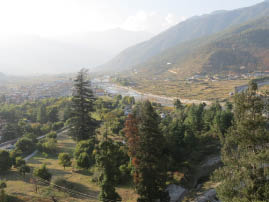
Back to Paro |
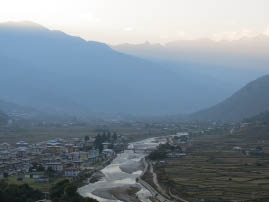
Back to Paro |
After our glorious last day in Bhutan, we return to our wretched hotel hoping for some hot water and the basics we expect from a hotel room.
After the mutiny from last night’s hotel fiasco, Karma changes our Farewell dinner location. We were scheduled to eat in that dingy hotel basement, but now will dine at a little place in Paro operated by the women who catered our picnic. Our spirits are lifting.
We shower; most of us find a bit of hot water and then walk through mud holes and traffic to cross the bridge to meet our van. We drive to Paro and find the nice, friendly, eating place in town. It is a happy place in a room on a second floor, tucked away without a sign. We dine happily at one end of the table with our new best friends, Woo and Kai. Lovely evening.
|











